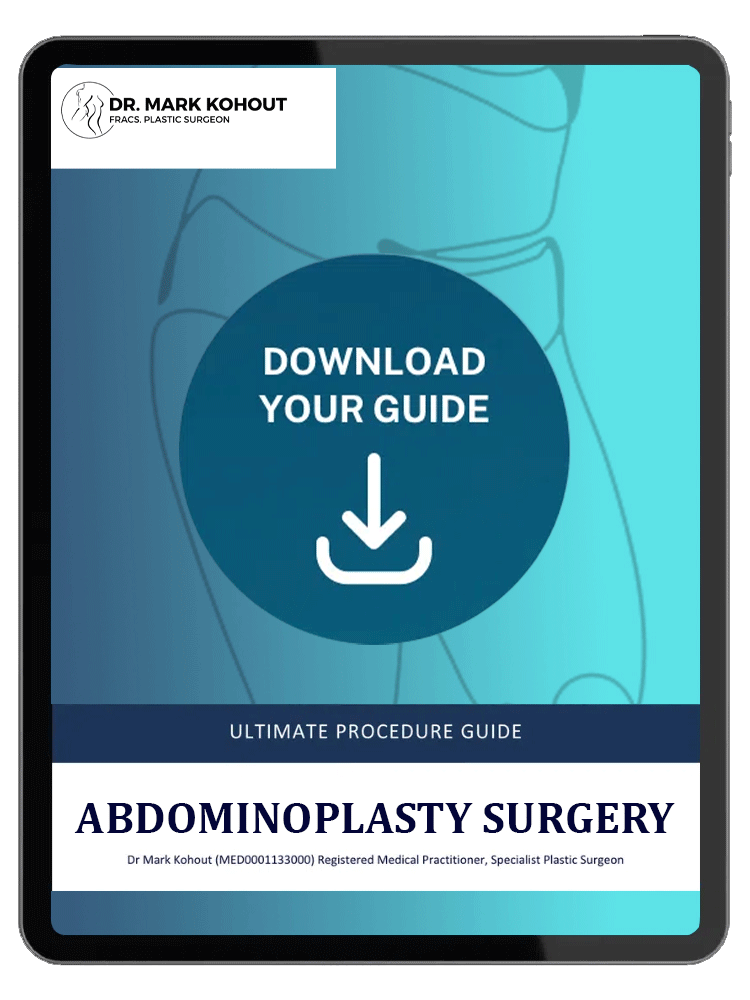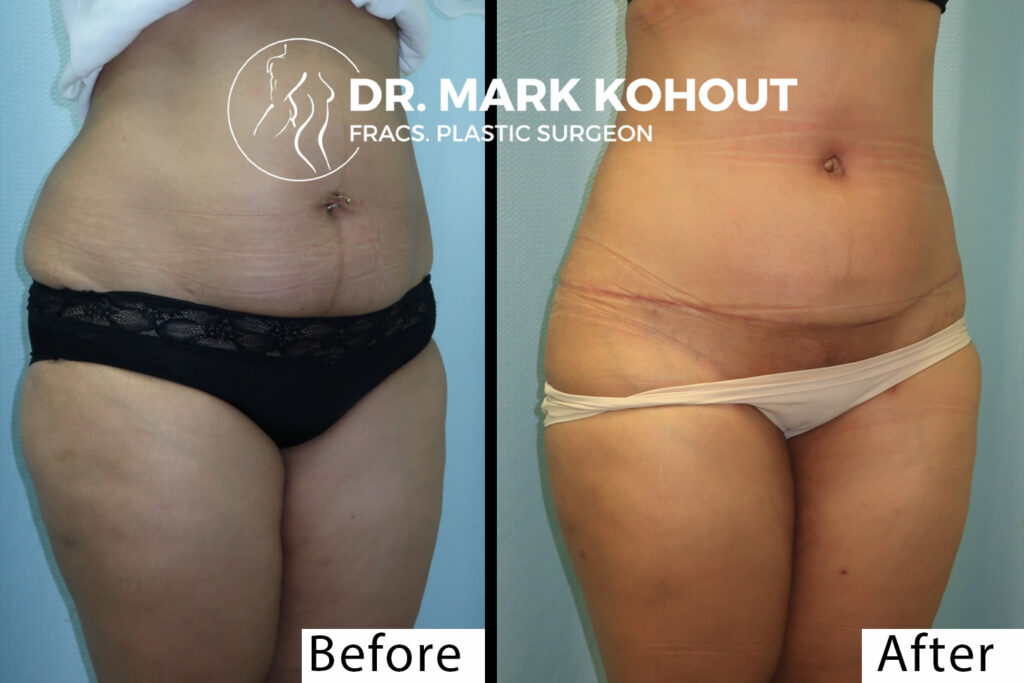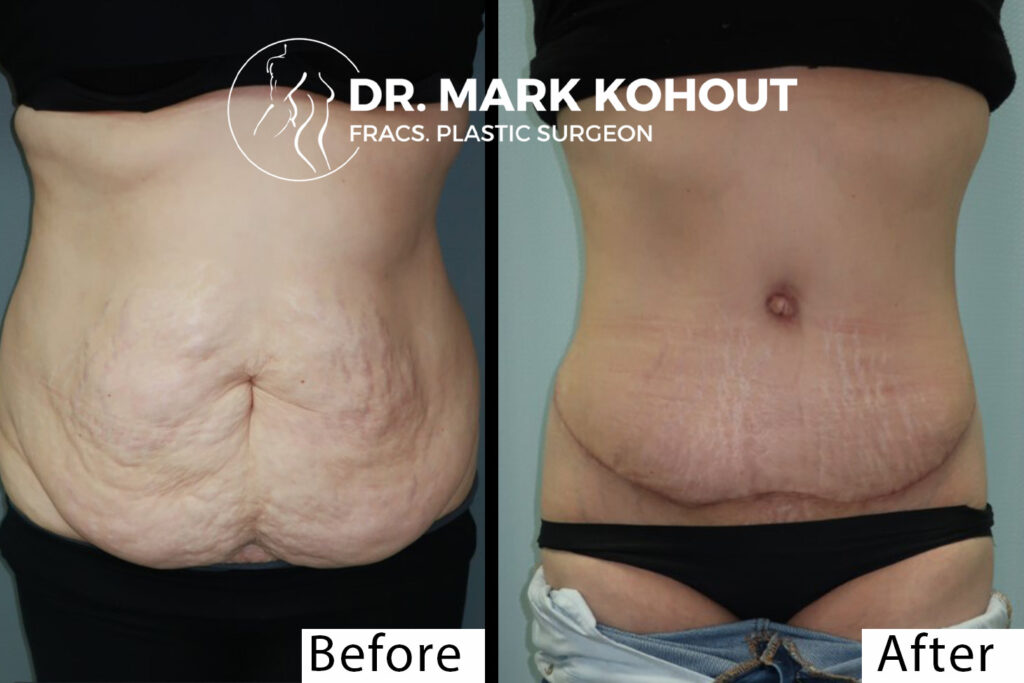
Introduction to Dr. Mark Kohout
If you’re considering abdominoplasty (tummy tuck) in Australia, it’s important to choose a surgeon with recognised qualifications and experience in this procedure. Dr. Mark Kohout is a FRACS qualified plastic surgeon with over 25 years of experience, specialising in cosmetic and reconstructive procedures both in Australia and internationally. His patient-centric approach allows each individual to receive comprehensive care tailored to their unique needs and goals. Abdominoplasty, one of Dr. Kohout’s areas of speciality, is a procedure he performs with a focus on safety, precision, and patient outcomes.
This blog answers some of the most frequently asked questions about abdominoplasty, offering insights into what to expect before, during, and after surgery. Whether you’re curious about candidacy, procedure details, recovery, or costs, you’ll find useful information to help you make informed decisions about your surgical journey.
What is Abdominoplasty?
Abdominoplasty, often referred to as a procedure that reshapes the abdomen, involves the removal of excess skin and fat, as well as the tightening of abdominal muscles to create a desired appearance. It is a popular choice for individuals who have experienced significant weight loss, or for women whose bodies have undergone changes after pregnancy. The surgery helps address areas where the skin and underlying tissues have not retracted back after these changes.
FAQs About Abdominoplasty 
Who is a suitable candidate for abdominoplasty?
Individuals considering abdominoplasty are often those who have excess lax skin or weakened abdominal muscles, typically following weight loss or childbirth. It is important to be in good overall health and to have realistic expectations about the outcome of the procedure. Candidates should also have a stable weight prior to undergoing surgery, as significant fluctuations can impact the long-term results.
A consultation with a qualified plastic surgeon is essential to assess whether abdominoplasty is the right option for you. During this meeting, your surgeon will evaluate your medical history, discuss your goals, and determine the best approach to addressing your desired outcome.
What happens during an abdominoplasty consultation?
During the consultation, Dr Kohout will review your medical history, current health, and expectations. You will be asked about any previous surgeries, medical conditions, or medications you are taking, as these can affect the procedure and recovery. He will examine your abdominal area, focusing on the skin’s elasticity, fat distribution, and the condition of your abdominal muscles.
In this session, you can also ask any questions or raise concerns you may have about the surgery. The consultation will provide you with a clear understanding of what the procedure involves, the risks and benefits, and the expected recovery timeline.
Do I need to lose weight before my abdominoplasty?
It is generally recommended that patients reach a stable weight before undergoing abdominoplasty. Significant weight loss after surgery may affect the final results, potentially leading to additional skin laxity. Ideally, you should be close to your target weight and have maintained it for some time before considering surgery. Dr Kohout will assess your individual case to determine the best course of action.
How is abdominoplasty performed?
Abdominoplasty is typically performed under general anaesthesia. Dr Kohout makes an incision in the lower abdomen, usually positioned below the pubic bone to minimise its visibility. Excess skin and fat are removed, and the underlying abdominal muscles may be tightened, depending on your specific needs. In some cases, he may also reposition the navel to support a natural look post-surgery.
Once the necessary adjustments have been made, the incision is closed with sutures. The length and position of the incision will vary depending on the amount of excess skin and the extent of muscle repair required.
Will liposuction work instead of abdominoplasty?
Liposuction and abdominoplasty address different concerns. Liposuction is primarily used to remove excess fat but does not deal with loose skin or weakened abdominal muscles, which abdominoplasty targets. Depending on your goals and the condition of your abdominal area, your surgeon may recommend one or both procedures. Liposuction can sometimes be combined with abdominoplasty with the aim of achieving a more comprehensive result.
How long does the surgery take?
The duration of abdominoplasty can vary depending on the complexity of the surgery and the individual patient. On average, the procedure takes between two to four hours. More extensive cases, such as those involving a significant amount of skin removal or muscle repair, may take longer. Dr Kohout will provide a more specific timeline based on your personal surgical plan at the completion of your consultation.
What can I expect during the recovery period?
After the surgery, you are usually required to stay in the hospital overnight for monitoring. Following discharge, you will need to follow Dr Kohout’s instructions closely to aid your recovery. This includes wearing a compression garment to control swelling, avoiding strenuous activities, and taking any prescribed medication to manage discomfort.
It’s important to allow your body enough time to heal, and you will need to take time off work and other activities. Most people are able to resume light activities within a couple of weeks, but full recovery can take several months. The length of your recovery will depend on the extent of your surgery and how well your body heals.
How long do I need to take off work after abdominoplasty?
The amount of time you will need off work depends on the nature of your job and the extent of your surgery. For most patients, a two to four-week recovery period is typical. However, if your job involves heavy lifting or physical exertion, you may need a longer recovery time. Your surgeon will provide personalised advice based on your surgery and overall health.
When can I go back to exercise?
It is advised to avoid strenuous exercise for at least six to eight weeks following abdominoplasty. Gentle activities like walking can often be resumed earlier, but anything that strains the abdominal area should be avoided until Dr Kohout gives you clearance to return to more intense physical activities. For a more detailed breakdown of timelines and safe activities, you can read our guide on return to exercise after abdominoplasty.
Are there any risks associated with abdominoplasty?
Like any surgical procedure, abdominoplasty carries some risks, including infection, bleeding, scarring, and reactions to anaesthesia. However, choosing a qualified and experienced plastic surgeon can help minimise these risks. Dr Kohout will discuss the potential complications with you during your consultation and provide advice on how to reduce the chances of complications.
It’s important to follow all post-operative care instructions and attend any follow-up appointments to monitor your recovery is progressing as expected.
What can I do to prepare for my abdominoplasty?
Preparation for abdominoplasty includes following pre-operative instructions from Dr Kohout. This may involve quitting smoking (including all nicotine products), adjusting medications, and arranging for someone to assist you during the initial stages of recovery. Eating a balanced diet and maintaining a stable weight will also help optimise your results and support a steady recovery.
Will I have scars after the procedure?
Scarring is an inevitable part of the healing process following abdominoplasty. However, experienced surgeons are adept at placing incisions in less noticeable areas. The appearance of scars will also fade over time, and with proper care, they may become less noticeable.
Surgeons may provide recommendations on how to manage scarring, such as using topical treatments or silicone-based products. While scars are permanent, many patients find that the benefits of the procedure outweigh the presence of scars.
How soon after abdominoplasty can I get pregnant?
It is advisable to wait until after you have completed your family before undergoing abdominoplasty, as pregnancy can reverse the results of the procedure by stretching the skin and muscles again. However, if you become pregnant after surgery, it is generally considered safe, though you may choose to have further surgery depending on changes to your abdominal area.
How much does abdominoplasty cost in Australia?
The cost of abdominoplasty in Australia can vary based on several factors, including the surgeon’s fees, the complexity of the procedure, and whether it is performed in a private or public hospital. On average, you can expect to pay between AUD $14,000 and AUD $25,000 for abdominoplasty.
Is Tummy Tuck (Abdominoplasty) covered by Insurance?
It’s important to note that private health insurance may cover part of the cost if the surgery is deemed medically necessary, such as in cases where excess skin is causing significant discomfort or health issues or muscle separation is beyond a 3cm gap. However, cosmetic abdominoplasty performed purely for aesthetic reasons is not covered by insurance.
Will there be much pain after surgery?
Some discomfort and pain are expected after abdominoplasty, especially in the first few days. Dr Kohout will provide pain management options, including medications, to keep you comfortable during recovery. Pain levels vary from person to person, but most patients find the discomfort manageable with proper care.
Can I have children after abdominoplasty?
Yes, you can still have children after abdominoplasty. However, as mentioned earlier, pregnancy can affect the results of your surgery. For the optimal long-term outcome, it is often recommended to wait until you have completed your family before undergoing the procedure.
Can abdominoplasty be combined with other procedures?
Yes, abdominoplasty is sometimes combined with other surgical procedures, such as liposuction or breast surgery. Combining procedures can help reduce the overall recovery time. However, it’s important to discuss any additional procedures with your surgeon to confirm that combining them is suitable and safe for your individual circumstances.
How long do the results of abdominoplasty last?
The results of abdominoplasty are considered long-lasting, particularly if you maintain a stable weight and lead a healthy lifestyle after surgery. While the procedure can significantly address the appearance of the abdomen, it cannot prevent future changes in the body due to ageing, weight fluctuations, or pregnancy.
Maintaining your results will largely depend on your commitment to healthy habits, such as regular exercise and a balanced diet.
Is there an age limit for abdominoplasty?
There is no specific age limit for abdominoplasty, but you should be in good overall health and have realistic expectations about the outcome. The procedure can be performed on adults of various ages, but factors such as skin elasticity, healing ability, and overall health can influence the results and recovery process.
Older patients may need a more thorough evaluation to ensure they are suitable candidates for surgery, particularly if they have any pre-existing health conditions.
How do I choose a surgeon for abdominoplasty?
Choosing a qualified and experienced surgeon is paramount for supporting an optimal abdominoplasty outcome. Look for a surgeon who is accredited by the relevant medical boards and has a strong track record of performing body contouring surgeries. It’s also important to feel comfortable with your surgeon and confident in their ability to understand your goals and expectations.
Abdominoplasty Surgery Before and After Images
During your consultation, ask to see before-and-after photos of previous patients, enquire about the surgeon’s experience with abdominoplasty, and discuss any concerns you may have. An experienced surgeon will provide clear answers and guide you through the decision-making process.
Abdominoplasty is a popular procedure that may offer significant benefits for those looking to address the shape of their abdomen. With the right surgeon and proper care, many patients experience long-lasting results. It’s important to fully understand the process, risks, and benefits before making a decision, and to choose a surgeon who prioritises your safety and well-being.
Here are the reference links related to abdominoplasty in Australia:
Related Blog Posts
Tips to Help Maintain Your Abdominoplasty…
Congratulations on undergoing a tummy tuck procedure. However, the journey doesn’t end there. To ensure the longevity of your results and protect your investment, it’s crucial to adopt certain lifestyle adjustments and…
Techniques in Tummy Tuck – Abdominoplasty:…
Popular Abdominoplasty Techniques in 2025 The field of tummy tuck – abdominoplasty surgery continues to advance, offering patients diverse options. In this blog, Sydney Plastic Surgeon Dr Mark Kohout will discuss some of the…
Abdominoplasty Medicare Cover – Will Medicare…
Will Medicare Cover My Abdominoplasty/ Tummy Tuck? Are you considering an abdominoplasty, commonly known as a tummy tuck, but wondering if Medicare will help cover the cost? This procedure can help eliminate…









